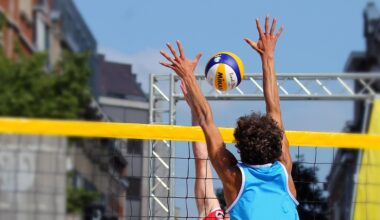Best Practices for Ankle Flexibility Training in Sports
Ankle flexibility is crucial for athletes, contributing to improved performance and reduced injury risk. Incorporating targeted workouts can enhance the range of motion and functional movement. Start with a warm-up that includes gentle movements to prepare the ankles for stretching. This sets the stage for deeper flexibility exercises. Options include ankle circles, heel raises, and toe taps, which are beneficial for loosening tight muscles and joints. Following your warm-up, static stretches are effective for promoting flexibility. Common stretches involve standing with one foot forward and leaning into the stretch while keeping the back leg straight. This action elongates the calf muscles, essential for ankle mobility. Additionally, consider dynamic stretches like walking lunges to engage dynamic flexibility. These exercises prepare the muscles for movement, combining strength with flexibility. It’s important to gradually increase the intensity and duration of your practices to avoid over-exertion. Advanced techniques such as proprioceptive neuromuscular facilitation (PNF) stretching offer added benefits. This technique promotes greater flexibility gains by alternating contracting and relaxing the muscles involved. Regularly integrating these enhanced practices will yield lasting results.
Importance of Ankle Mobility in Sports
Ankle mobility is integral to many athletic disciplines, influencing overall performance and stability. Improved mobility enables athletes to execute movements more effectively, reducing the risks of strains or sprains. The ability to move freely at the ankle joint significantly impacts foot placement, balance, and landing mechanics. This becomes particularly crucial in sports such as basketball, soccer, and track and field, where rapid changes in direction occur frequently. A strong ankle allows for quicker starts and stops, contributing to better speed and agility. By focusing on ankle flexibility training, athletes can create a strong foundation for their lower body movements. They also promote greater torque generation through joint range of motion, particularly during explosive actions like jumping or sprinting. Additionally, improved ankle mobility can enhance proprioception, helping athletes maintain control over their body positioning. This control aids in injury prevention, especially in high-impact sports. Regular training and flexibility sessions reinforce the tendons and ligaments surrounding the ankle, enhancing durability. Ultimately, integrating ankle mobility training into regular workout routines enhances performance longevity and resilience.
There are several effective ankle flexibility exercises that athletes can incorporate into their training regimen. One fundamental exercise includes the use of resistance bands, which provide additional resistance during stretching. Loop the band around the forefoot and pull gently while pointing and flexing the foot. This exercise targets both the calf muscles and the Achilles tendon. Another beneficial exercise involves using a wall or a sturdy surface to assist in balance. Stand a few feet away and slowly lean into the wall bending the knees while keeping the heels flat. This stretch is effective in increasing the range of movement in the ankle joint. Athletes may also benefit from utilizing foam rollers to release tension in tight calf muscles. Rolling the calf muscles before doing static stretches helps increase blood flow, promoting flexibility. Consider incorporating a daily routine of ankle mobility exercises to maximize results, even on rest days. Performing these exercises consistently makes a noticeable difference over time, allowing for enhanced performance during sports activities. Lastly, mindfulness when performing these exercises ensures that athletes are focused, which can improve the effectiveness of their training.
Tips for Incorporating Ankle Flexibility Training
To successfully incorporate ankle flexibility workouts into your training, establishing a dedicated routine is vital. Schedule specific days to focus on ankle mobility, ensuring that your muscles have time to recover between sessions. Begin with lighter stretches and progress to more challenging exercises as flexibility increases. Consistency is key; engage in flexibility work several times a week rather than cramming it into a single session. This regular practice builds strength and endurance in the ankle, leading to better results. Utilize technology such as apps or timers to help maintain the proper duration for stretching each set. Aim for at least 30 seconds per stretch to achieve optimal results. Partnering with a coach or trainer can also provide guidance on the most effective techniques to enhance ankle flexibility. They can offer personalized feedback and ensure exercises are performed correctly to prevent injury. Tracking progress through daily notes or progress photos adds motivation to the routine, as seeing improvement can inspire continued effort. Balancing flexibility training with strength development is necessary for optimal athletic performance.
Utilizing dynamic stretches offers an excellent way to enhance ankle mobility while also incorporating movement training. Exercises such as carioca or high knees encourage the use of ankle flexibility in real time, promoting motor pattern refinement. These movements require the athlete to actively engage their ankles while maintaining speed and agility. Additionally, incorporating sport-specific drills helps athletes apply their enhanced mobility directly to the sport context. Consider hopping or skipping drills that require intricate ankle movements in different planes. This not only aids in building strength but also improves coordination. Resistance training targeting the lower body plays a significant role as well. Exercises like squats and deadlifts can develop strength around the ankle, further enhancing overall flexibility. By integrating a balance of strength and flexibility, athletes ensure that the joints remain stable without sacrificing the necessary range of motion. Cross-training activities, like dance or martial arts, can also improve overall ankle flexibility and awareness. Make sure to listen to your body to avoid excessive fatigue or strain on the ankle joint during this process.
Monitoring Progress and Avoiding Injury
When integrating ankle flexibility training, it’s essential to monitor progress meticulously. Keeping a training journal enables athletes to note improvements in both flexibility and mobility. This documentation can serve as a useful reference to adjust training intensity over time. Pay close attention to any signs of discomfort or pain during exercises—these could indicate overstretching or an underlying issue that requires attention. Proper warm-up and cool-down routines are critical components in injury prevention within any flexibility regimen. Ensure that muscles are adequately prepared before beginning challenging movements. A proper cooldown allows the body to gradually return to a resting state, helping reduce muscle soreness. Additionally, appropriate footwear should not be overlooked; supportive shoes can significantly enhance ankle stability and prevent unnecessary strain. If pain persists, seeking professional advice from a physical therapist or trainer is highly recommended. They can offer personalized insight into strengthening exercises specifically tailored to the individual’s needs. Ultimately, maintaining a focus on recovery and rest will enhance the efficacy of the flexibility training program.
In conclusion, ankle flexibility is indispensable for athletes aiming to enhance performance and reduce injury risks. Structured flexibility training that incorporates various exercises is essential for developing mobile and agile ankles. By combining dynamic, static, and resistance-based workouts, athletes can build a comprehensive approach to flexibility improvement. Monitoring progress throughout the routine encourages ongoing commitment to improving ankle mobility. Deepening understanding through research and sports science will provide further insight into effective practices. Consider developing a specific goal for ankle flexibility as part of a holistic training program. Bringing awareness to the ankle’s role in overall performance can elevate focus during workouts. Furthermore, collaborating with coaches or joining training workshops can expand knowledge and techniques. Sharing insights with fellow athletes fosters a supportive community, propelling everyone’s growth. Ultimately, achieving optimal ankle flexibility requires dedication, consistency, and education. Athletes must remember that improvements will take time, but results from diligent practice are well worth the effort. Through effective ankle flexibility routines, athletes can enjoy improved capabilities while competing on the field, court, or track, leading to greater success.


